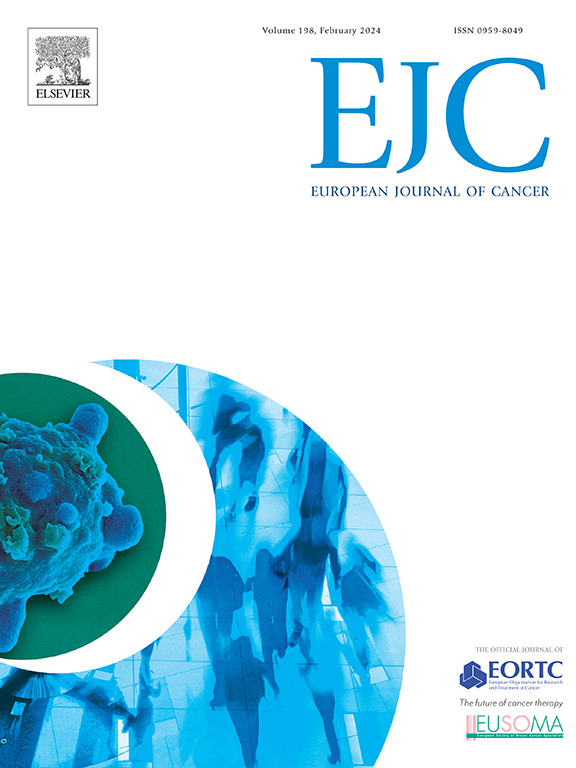Histological proven AI performance in the UKLS CT lung cancer screening study: Potential for workload reduction
IF 7.6
1区 医学
Q1 ONCOLOGY
引用次数: 0
Abstract
Purpose
Artificial intelligence (AI) could reduce lung cancer screening computer tomography (CT)-reading workload if used as a first-reader, ruling-out negative CT-scans at baseline. Evidence is lacking to support AI performance when compared to gold-standard lung cancer outcomes. This study validated the performance of a commercially available AI software in the UK lung cancer screening (UKLS) trial dataset, with comparison to human reads and histological lung cancer outcomes, and estimated CT-reading workload reduction.
Methods
1252 UKLS-baseline-CT-scans were evaluated independently by AI and human readers. AI performance was evaluated on two-levels. Firstly, AI classification and individual reads were compared to a EU reference standard (based on NELSON2.0-European Position Statement) determined by a European expert panel blinded from individual results. A positive misclassification was defined as a nodule positive read ≥ 100mm3 and no/<100mm3 nodules in the expert read; A negative misclassification was defined as a nodule negative read, whereas an indeterminate or positive finding in the expert read. Secondly, AI nodule classification was compared to gold-standard histological lung cancer outcomes. CT-reading workload reduction was calculated from AI negative CT-scans when AI was used as first-reader.
Results
Expert panel reference standard reported 815 (65 %) negative and 437 (35 %) indeterminate/positive CT-scans in the dataset of 1252 UKLS-participants. Compared to the reference standard, AI resulted in less misclassification than human reads, NPV 92·0 %(90·2 %-95·3 %). On comparison to gold-standard, AI detected all 31 baseline-round lung cancers, but classified one as negative due to the 100mm3 threshold, NPV 99·8 %(99·0 %-99·9 %). Estimated maximum CT-reading workload reduction was 79 %.
Conclusion
Implementing AI as first-reader to rule-out negative CT-scans, shows considerable potential to reduce CT-reading workload and does not lead to missed lung cancers.
组织学证实的AI在UKLS CT肺癌筛查研究中的表现:减少工作量的潜力
目的:人工智能(AI)可以减少肺癌筛查计算机断层扫描(CT)阅读工作量,如果用作第一阅读器,排除基线CT扫描阴性的可能性。与金标准肺癌结果相比,缺乏支持人工智能表现的证据。本研究验证了商用人工智能软件在英国肺癌筛查(UKLS)试验数据集中的性能,与人类阅读和组织学肺癌结果进行了比较,并估计了ct阅读工作量的减少。方法1252例ukls基线ct扫描由人工智能和人类读者独立评估。人工智能的表现分为两个等级。首先,将人工智能分类和个人读数与欧盟参考标准(基于nelson2.0 -欧洲立场声明)进行比较,该标准由欧洲专家小组确定,不考虑个人结果。阳性误分定义为结节阳性读数≥ 100mm3,专家读数无/<;100mm3结节;阴性错误分类被定义为结节阴性阅读,而专家阅读的不确定或阳性发现。其次,将AI结节分类与金标准肺癌组织学结果进行比较。当使用AI作为第一阅读者时,通过AI阴性ct扫描计算ct阅读工作量减少。结果专家小组参考标准在1252名ukls参与者的数据集中报告了815例(65 %)阴性ct扫描和437例(35 %)不确定/阳性ct扫描。与参考标准相比,人工智能的误分类率低于人类,NPV为92.0 %(92.0 %- 95.3 %)。与金标准相比,AI检测到所有31例基线轮肺癌,但由于100mm3阈值,NPV为99.8 %(99.0 %- 99.9 %),因此将1例诊断为阴性。估计最大的ct阅读工作量减少为79 %。结论采用人工智能作为第一阅读器来排除阴性ct扫描,显示出相当大的潜力,可以减少ct阅读工作量,并且不会导致漏诊肺癌。
本文章由计算机程序翻译,如有差异,请以英文原文为准。
求助全文
约1分钟内获得全文
求助全文
来源期刊

European Journal of Cancer
医学-肿瘤学
CiteScore
11.50
自引率
4.80%
发文量
953
审稿时长
23 days
期刊介绍:
The European Journal of Cancer (EJC) serves as a comprehensive platform integrating preclinical, digital, translational, and clinical research across the spectrum of cancer. From epidemiology, carcinogenesis, and biology to groundbreaking innovations in cancer treatment and patient care, the journal covers a wide array of topics. We publish original research, reviews, previews, editorial comments, and correspondence, fostering dialogue and advancement in the fight against cancer. Join us in our mission to drive progress and improve outcomes in cancer research and patient care.
 求助内容:
求助内容: 应助结果提醒方式:
应助结果提醒方式:


